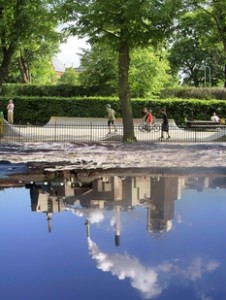 A new study led by sustainability scientist Matei Georgescu reveals some of the dynamics at play as one region of the country, the Central Valley of California, braces for substantial population growth and all it entails. The study, based on computer simulations of rural to urban land conversion, shows that as areas of California grow and develop, the resulting built environment could generate additional heat.
Georgescu used ensemble-based simulations employing EPA projections of urban growth to assess urban expansion climate effects by the year 2100 in the Central Valley. He first assessed the resulting rise in regional temperatures and then explored several temperature mitigating strategies for buildings: cool roofs, green roofs and hybrid approaches. He found that as the state deploys temperature-mitigating technologies, there are secondary effects that appear to take place, such as less daytime air turbulence, which could lead to higher concentrations of pollutants.
But the urban heat island effect can be mitigated using new technologies and the latest in sustainable design techniques, said Georgescu, whose “Challenges associated with adaptation to future urban expansion” appears in the April 1 issue of the Journal of Climate. Finding the right combinations of technologies and techniques will be key.
A new study led by sustainability scientist Matei Georgescu reveals some of the dynamics at play as one region of the country, the Central Valley of California, braces for substantial population growth and all it entails. The study, based on computer simulations of rural to urban land conversion, shows that as areas of California grow and develop, the resulting built environment could generate additional heat.
Georgescu used ensemble-based simulations employing EPA projections of urban growth to assess urban expansion climate effects by the year 2100 in the Central Valley. He first assessed the resulting rise in regional temperatures and then explored several temperature mitigating strategies for buildings: cool roofs, green roofs and hybrid approaches. He found that as the state deploys temperature-mitigating technologies, there are secondary effects that appear to take place, such as less daytime air turbulence, which could lead to higher concentrations of pollutants.
But the urban heat island effect can be mitigated using new technologies and the latest in sustainable design techniques, said Georgescu, whose “Challenges associated with adaptation to future urban expansion” appears in the April 1 issue of the Journal of Climate. Finding the right combinations of technologies and techniques will be key.Study explores heat-mitigating technologies for urbanizing region
 A new study led by sustainability scientist Matei Georgescu reveals some of the dynamics at play as one region of the country, the Central Valley of California, braces for substantial population growth and all it entails. The study, based on computer simulations of rural to urban land conversion, shows that as areas of California grow and develop, the resulting built environment could generate additional heat.
Georgescu used ensemble-based simulations employing EPA projections of urban growth to assess urban expansion climate effects by the year 2100 in the Central Valley. He first assessed the resulting rise in regional temperatures and then explored several temperature mitigating strategies for buildings: cool roofs, green roofs and hybrid approaches. He found that as the state deploys temperature-mitigating technologies, there are secondary effects that appear to take place, such as less daytime air turbulence, which could lead to higher concentrations of pollutants.
But the urban heat island effect can be mitigated using new technologies and the latest in sustainable design techniques, said Georgescu, whose “Challenges associated with adaptation to future urban expansion” appears in the April 1 issue of the Journal of Climate. Finding the right combinations of technologies and techniques will be key.
A new study led by sustainability scientist Matei Georgescu reveals some of the dynamics at play as one region of the country, the Central Valley of California, braces for substantial population growth and all it entails. The study, based on computer simulations of rural to urban land conversion, shows that as areas of California grow and develop, the resulting built environment could generate additional heat.
Georgescu used ensemble-based simulations employing EPA projections of urban growth to assess urban expansion climate effects by the year 2100 in the Central Valley. He first assessed the resulting rise in regional temperatures and then explored several temperature mitigating strategies for buildings: cool roofs, green roofs and hybrid approaches. He found that as the state deploys temperature-mitigating technologies, there are secondary effects that appear to take place, such as less daytime air turbulence, which could lead to higher concentrations of pollutants.
But the urban heat island effect can be mitigated using new technologies and the latest in sustainable design techniques, said Georgescu, whose “Challenges associated with adaptation to future urban expansion” appears in the April 1 issue of the Journal of Climate. Finding the right combinations of technologies and techniques will be key.